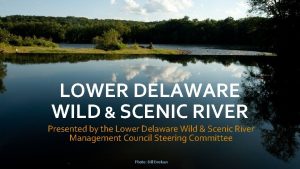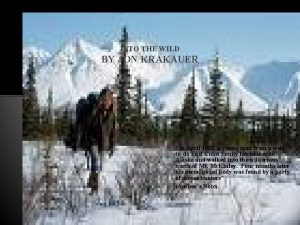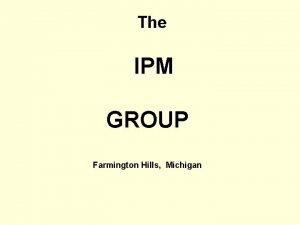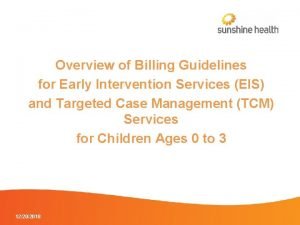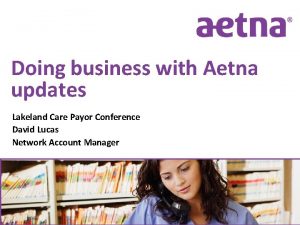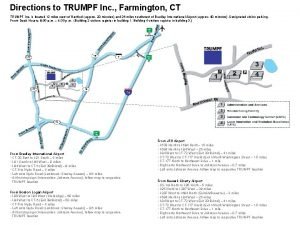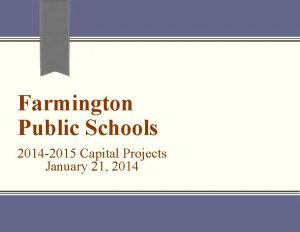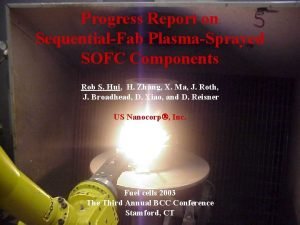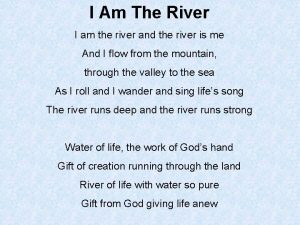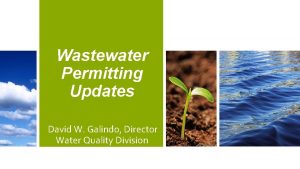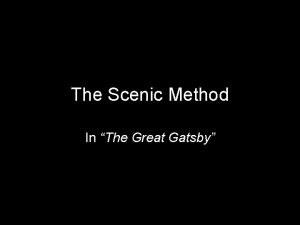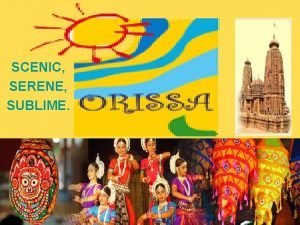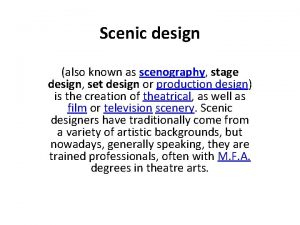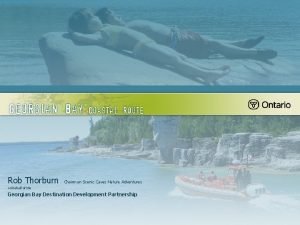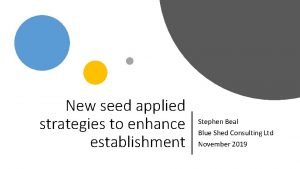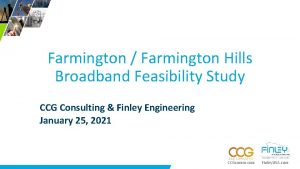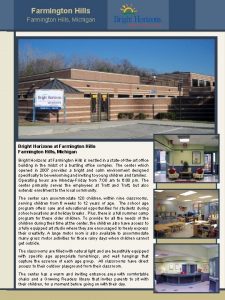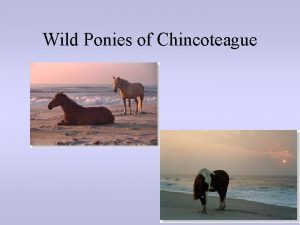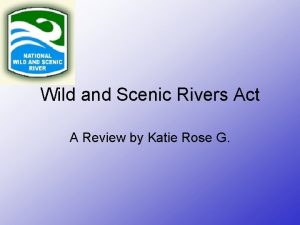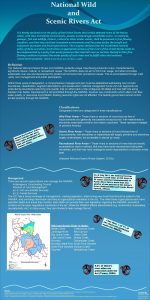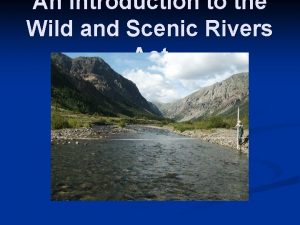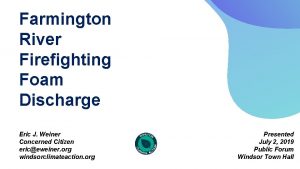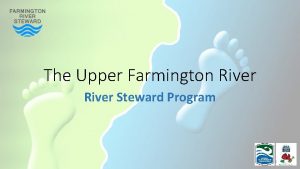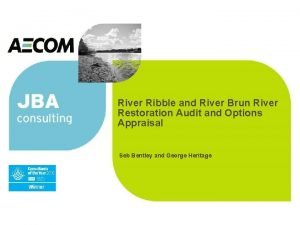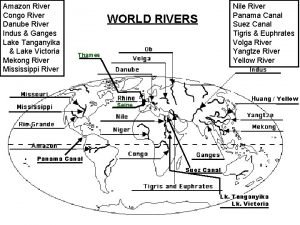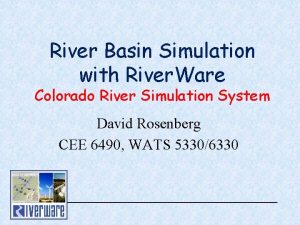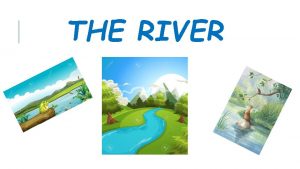What Makes the Farmington River Wild and Scenic




















- Slides: 20

What Makes the Farmington River Wild and Scenic? Prepared by the Farmington River Coordinating Committee

“Certain selected rivers of the Nation which, with their immediate environments, possess outstandingly remarkable scenic, recreational, geologic, fish and wildlife, historic, cultural or other similar values, shall be preserved in free -flowing condition, and that they and their immediate environments shall be protected for the benefit and enjoyment of present and future generations. The Congress declares that the established national policy of dam and other construction at appropriate sections of the rivers of the United States needs to be complemented by a policy that would preserve other selected rivers or sections thereof in their free-flowing condition to protect the water quality of such rivers and to fulfill other vital national conservation purposes. (Wild & Scenic Rivers Act, 1968)

Classifications: Wild River Areas Free of impoundments and generally inaccessible except by trail, with watersheds or shorelines essentially primitive and waters unpolluted. Scenic River Areas Free of impoundments, with shorelines or watersheds still largely primitive and shorelines largely undeveloped, but accessible in places by roads. Recreational River Areas Readily accessible by road or railroad, that may have some development along their shorelines, and that may have undergone some impoundment or diversion in the past.

Outstandingly Remarkable Values (ORVs) Regionally Significant Unique, Rare or Exemplary… Scenic Recreational Geological Ecological Historical Cultural Archeological

Benefits of the Designation Ø Honor and Pride Ø Local Control Through Zoning and Stewardship Ø Federal Review of Federally-Funded and Permitted Projects Ø Boost to Local Economies Ø Leveraging Resources with Partners

Farmington River: Connecticut’s First Wild & Scenic River ô Designated in 1994 under the National Wild & Scenic Rivers Act ôDesignation included 14 miles of the West Branch – from just below Goodwin dam in Hartland to the New Hartford – Canton town line

Upper Farmington’ s Classificatio n and ORVs Ø Classified as “recreational” due to the level of human activity and development in the river corridor and accessibility from roads and bridges. Ø Free-flowing condition Ø High water quality Ø A regionally unique combination of recreational opportunities Ø Regionally exemplary fish habitat for trout and Atlantic salmon Ø Regionally unique wildlife habitat – particularly for bald eagles Ø Regionally exemplary historic

Farmington River Coordinating Committee (FRCC) Ø Created by Congress in 1994 at time of W&S designation Ø Includes: Barkhamsted, Canton, Colebrook, Hartland, and New Hartford), CT DEEP, the MDC, FRWA, and National Park Service Ø Farmington River Anglers Association (FRAA) added several years ago FRCC coordinates with stakeholders on river activities to ensure long-term stewardship of the river.

FRCC’s Major Roles Ø Ø Partnership with local, state, and federal governments, and local organizations and property owners Provide a forum for discussion of river issues Offer on-going education efforts to inform and inspire people of all ages Maintain records - continually seek more information on the health of the river and its inhabitants

Examples of FRCC’s Work To Date

West River Road Bank Stabilization Completed 2003 n Project Total = $100, 000 n State of CT = $50, 000 n FRCC Funds = $10, 000 n Town of Barkhamsted = Labor and Equipment (Local match $40, 000) n FRWA = In-kind Support

Nepaug Forest Bank Stabilization Completed 2007 n Project Total = $11, 500 n In-Kind Contributions: CT DEP – Labor and Equipment MDC – Materials and Expertise FRCC – Project Coordination n Labor and Equipment = $4, 000

On-going Projects & Studies Ø Mussels, Snails, Crayfish Ø Flow Management Ø Fish Habitat Ø Access Management Ø Habitat Enhancement Ø Water Quality Monitoring Ø Invasive Plant Control

Outreach and Education n n n Open houses and exhibits Informational workshops Informational kiosks Newsletters www. Farmington. River. or g Junior River Rangers Program

FRCC Grants Program n n n Fish in Schools Programs Archeological Studies – Richard Smith site in Colebrook - and Squire’s Tavern property in Barkhamsted Natural Resource Inventories Land Trust Start Up and Land Protection Assistance Funds River Celebrations Stormwater Best Management Practices

Pat Keener and Nancy L. Johnson Scholarships Ø Scholarships to graduating H. S. seniors and college students from five-town W&S area going into environmental studies. Ø Created to honor Pat Keener from New Hartford – one of the first representatives, long-time chair of FRCC, and a great friend of the Farmington River - and Rep. Nancy Johnson who championed the river on many occasions – including getting the upper section W&S designation and Lower Farmington/Salmon Brook Study.

Land Protection and Land Trusts n Land Protection program to assist local Land Trusts in planning and land acquisition.

Partnering with Partnership Rivers Ø Ø Ø The Farmington W&S River is one of a dozen “Partnership Rivers” in the East that is managed under a similar partnership model. Each river has its own personality and players. Funding is sought collaboratively with the group as a program in the NPS budget.

Who is FRCC? Barkhamsted – Mario Santoro, Roger Behrens alt. Canton – Mark Quinlan alt. Colebrook – Ross Delaney; Tom Stanton alt. Hartland – Dan Bowler New Hartford – Alison Murdock; Joe Merlino alt. CT DEP – Susan Peterson FRAA – Nick Masi FRWA – David Sinish; Eileen Fielding alt. MDC – Tim Anthony; Carol Youell alt. NPS – Liz Lacy; Jamie Fosburgh alt.

Thank you for your continued support and stewardship of the Farmington Wild & Scenic River! FRCC’s office is located at Squire’s Tavern Peoples State Forest 100 East River Road Pleasant Valley, CT 06063 860 -379 -0282 Open most Wednesday mornings, Sunday afternoons www. Farmington. River. org
 Lower delaware national wild and scenic river
Lower delaware national wild and scenic river Mrs wild going wild
Mrs wild going wild Jim gallien
Jim gallien Casting and fabrication farmington hills mi
Casting and fabrication farmington hills mi Early intervention billing
Early intervention billing Farmington hills, mi 48333
Farmington hills, mi 48333 Trumpf ct
Trumpf ct Farmington roof repair
Farmington roof repair Pierce house farmington maine
Pierce house farmington maine 74 batterson park road farmington ct
74 batterson park road farmington ct I am the river and the river is me
I am the river and the river is me John graves scenic riverway
John graves scenic riverway Thickish figure of a woman
Thickish figure of a woman Scenic serene sublime
Scenic serene sublime Unit set design
Unit set design Scenic caves tickets online
Scenic caves tickets online Scenic painting real vs fake
Scenic painting real vs fake Javafx scenic view
Javafx scenic view Scenic gold seed treatment
Scenic gold seed treatment Harbor breeze tiempo
Harbor breeze tiempo Green river watershed
Green river watershed
